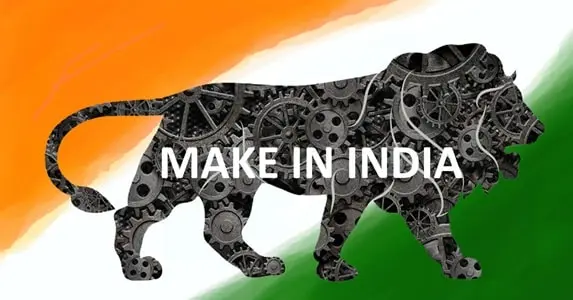“Make in India” is India’s big plan to be a top creator on the world stage. The goal is simple: boost our industries and create more jobs. Imagine a future where India makes what it needs and shines globally. However, this dream faces hurdles. The road has bumps—like not-so-great roads and complicated rules. Yet, it’s not just challenges; there are opportunities too. This journey is about balancing dreams and reality, making India a global manufacturing powerhouse.
Let’s further explore the advantages and disadvantages of the Make in India Scheme!

Advantages of Make in India Scheme
1. Boost to Manufacturing: One of the primary goals of Make in India is to enhance the manufacturing sector. The scheme aims to reduce reliance on imports and strengthen the country’s economic backbone by promoting indigenous production.
2. Job Creation: Increased manufacturing inevitably leads to more job opportunities. Make in India strives to address unemployment by fostering growth in textiles, electronics, and automobiles, thus contributing to economic development.
3. Foreign Direct Investment (FDI): The initiative encourages foreign companies to invest in India, fostering collaborations and partnerships. This influx of foreign capital not only boosts the economy but also brings in advanced technology and expertise.
4. Export Promotion: The emphasis on local production is accompanied by a push towards global competitiveness. Make in India seeks to position Indian products as global players, promoting exports and reducing trade deficits.
5. Skill Development: The demand for skill development for manufacturing is growing rapidly. The scheme aims to enhance the workforce’s skill sets, aligning them with the needs of modern industries.
6. Innovation Stimulus: Make in India encourages innovation by fostering an environment where businesses can experiment and develop new technologies, leading to advancements across various sectors.
7. Diversification of Industries: The initiative promotes the growth of diverse industries, reducing dependence on a single sector and creating a resilient economic ecosystem.
8. Rural Development: The focus on manufacturing extends to rural areas, providing employment opportunities and improving living standards in regions that traditionally face economic challenges.
9. Reduction in Trade Deficits: Making in India aims to narrow trade deficits by boosting exports, contributing to a healthier trade balance.
10. Global Recognition: Successful implementation of the initiative enhances India’s global reputation, attracting investment and partnerships with international businesses.
11. Strengthening Small and Medium Enterprises (SMEs): Make in India supports the growth of SMEs, fostering entrepreneurship and creating a more inclusive economic landscape.
12. Strategic Importance: A robust manufacturing sector enhances the country’s strategic importance by reducing dependence on imports for critical goods and services.
13. Improved Quality Standards: The initiative encourages a focus on quality, pushing industries to adhere to global standards, resulting in better products for domestic and international markets.
14. Balancing Urbanization: By promoting manufacturing across urban and rural areas, Make in India helps balance the pace of urbanization and prevent the concentration of industries in specific regions.
15. Social Upliftment: Increased job opportunities and economic growth contribute to social upliftment, addressing issues of poverty and fostering a more equitable society.
16. Research and Development Boost: Make in India encourages increased spending on research and development, fostering a culture of innovation and technological advancement.
17. Strategic Independence: By manufacturing critical goods domestically, India enhances its strategic independence, reducing vulnerability to global disruptions.
Disadvantages of Make in India Scheme
1. Infrastructural Challenges: While the initiative strives for industrial growth, the existing infrastructure often needs to improve. More adequate roads, power supply, and logistical facilities can help the seamless operation of manufacturing units.
2. Complex Regulatory Environment: Despite efforts to simplify regulations, bureaucratic red tape and complex procedures persist. This can discourage both domestic and foreign investors, hindering the smooth implementation of the Make in India vision.
3. Environmental Concerns: Rapid industrialization, if not managed responsibly, can lead to environmental degradation. The emphasis on production sometimes overshadows ecological considerations, leading to pollution and resource depletion.
4. Global Economic Uncertainties: The global economic landscape is dynamic, and external factors can impact the success of Make in India. Economic downturns or geopolitical tensions may affect foreign investment and trade, influencing the scheme’s outcomes.
5. Technology Disparities: While the initiative aims to attract advanced technology through FDI, there’s a risk of creating a technology gap. Local industries may need help to keep pace with the latest advancements, potentially leading to dependence on foreign expertise.
6. Land Acquisition Issues: Manufacturing expansion requires land, often leading to conflicts with local communities and concerns about displacement.
7. Labor Exploitation: In the race for competitiveness, labor exploitation is risky, with some industries compromising worker rights to cut costs.
8. Uneven Regional Development: Despite efforts, there’s a risk of uneven development, with certain regions benefitting more than others, exacerbating regional economic disparities.
9. Market Saturation: Intensive focus on certain industries may lead to market saturation, impacting the viability of businesses in crowded sectors.
10. Technological Unemployment: Automation and advanced technologies, while enhancing efficiency, may lead to job losses, particularly for low-skilled workers.
11. Cultural Impact: Rapid industrialization can have cultural implications, affecting traditional practices and ways of life in communities surrounding manufacturing hubs.
12. Supply Chain Vulnerabilities: Overreliance on certain supply chains, both domestic and international, can make industries vulnerable to disruptions, as witnessed during global crises.
13. Inflationary Pressures: Increased production costs and resource demand may contribute to inflationary pressures, affecting both businesses and consumers.
14. Health and Safety Concerns: Swift industrial growth may compromise health and safety standards, posing risks to workers and surrounding communities.
15. Corruption Risks: The complex nature of large-scale manufacturing projects can increase the risk of corruption, impacting the transparency and efficiency of the implementation process.
On A Concluding Note
In conclusion, the Make in India scheme is a double-edged sword, bringing both promises and challenges. While it strives to invigorate the manufacturing sector, it must address infrastructural bottlenecks, simplify regulations, and balance economic growth with environmental sustainability. The success of Make in India hinges on the ability to navigate these complexities and foster a conducive environment for holistic industrial development.
Anantha Nageswaran is the chief editor and writer at TheBusinessBlaze.com. He specialises in business, finance, insurance, loan investment topics. With a strong background in business-finance and a passion for demystifying complex concepts, Anantha brings a unique perspective to his writing.


